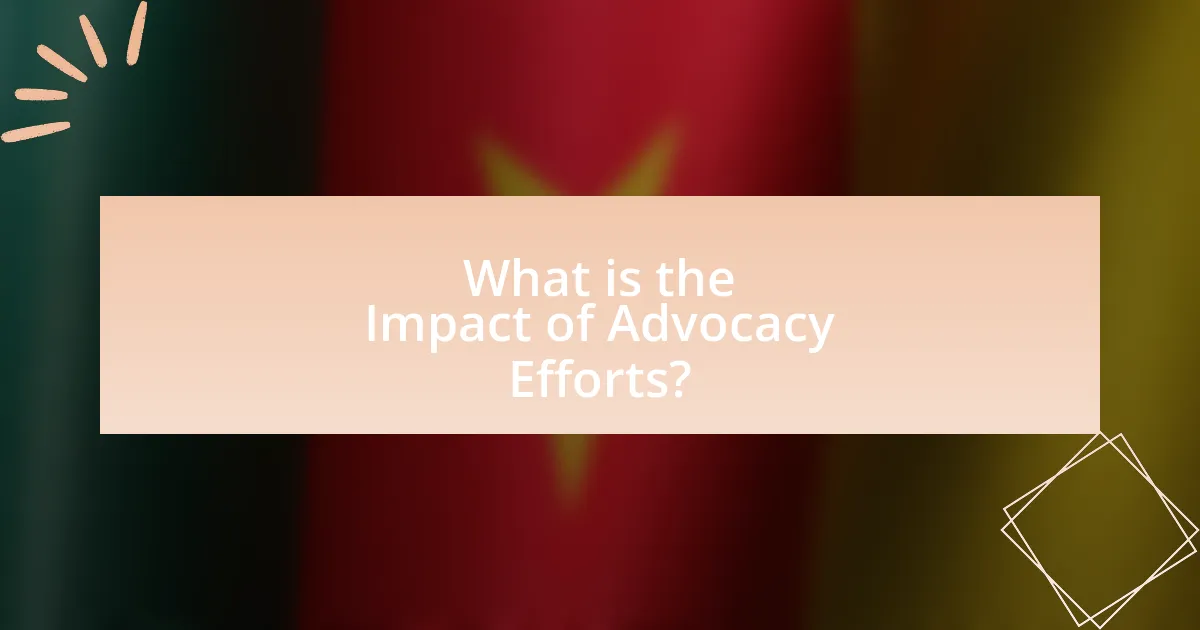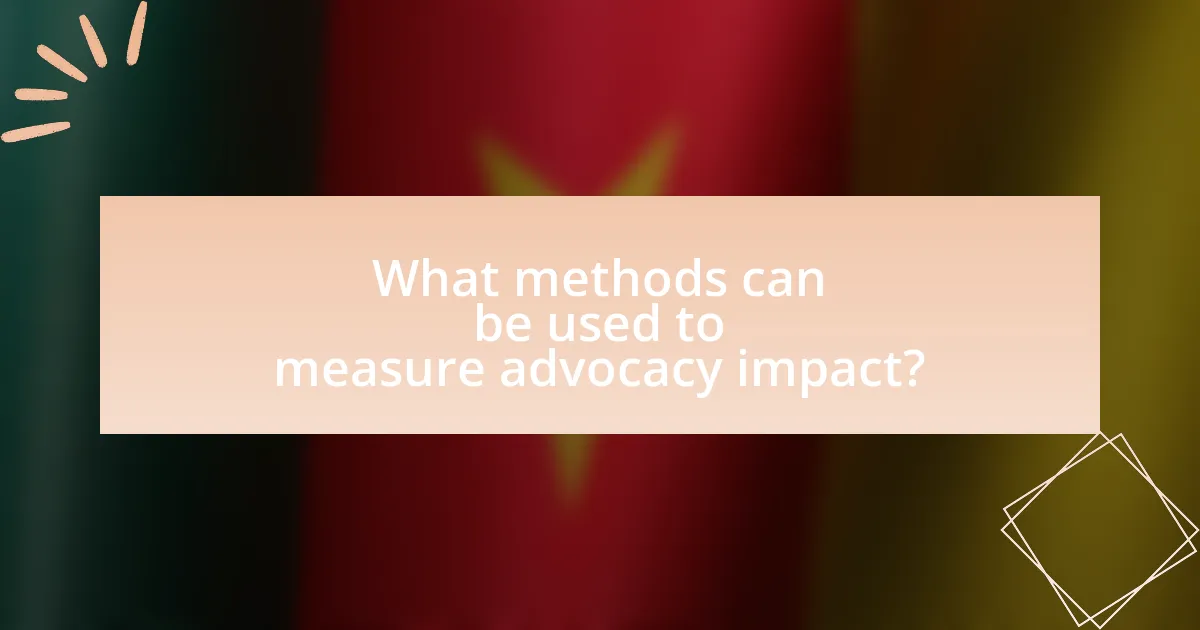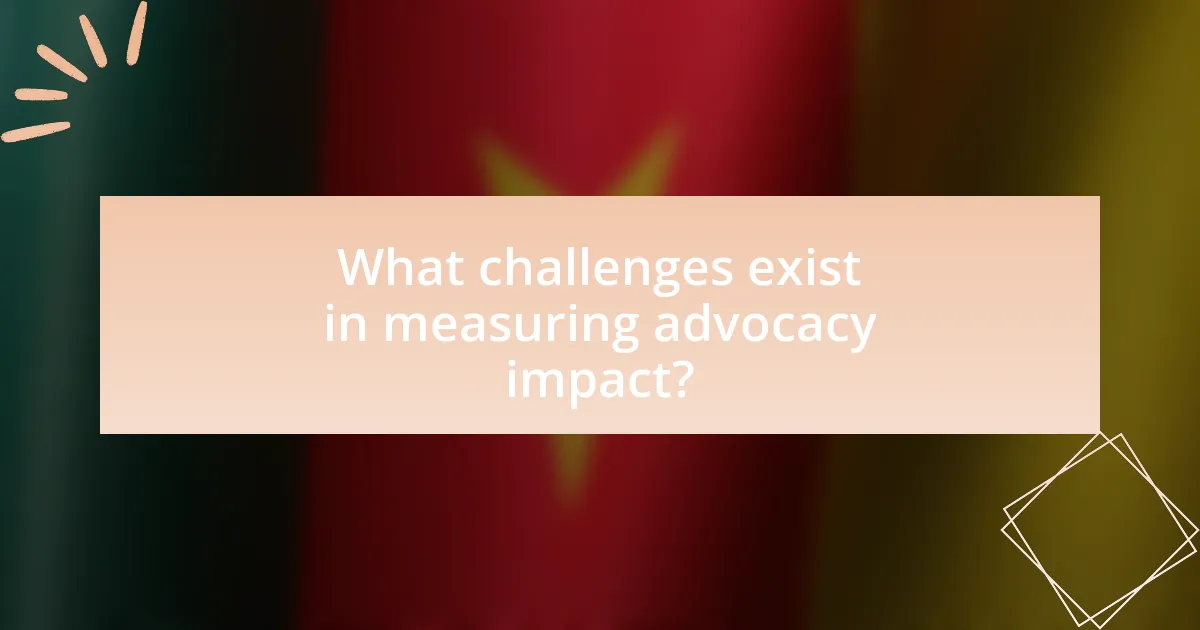The article focuses on measuring the impact of advocacy efforts, highlighting their significant influence on public policy, social change, and community awareness. It outlines key components of advocacy, such as awareness, education, mobilization, and policy change, and emphasizes the importance of establishing measurable objectives to assess effectiveness. Various methods for measuring advocacy impact, including quantitative metrics and qualitative assessments, are discussed, along with the challenges organizations face in attribution and data collection. The article also presents best practices for effective measurement, including setting clear objectives and continuous evaluation to enhance advocacy strategies.

What is the Impact of Advocacy Efforts?
Advocacy efforts significantly influence public policy, social change, and community awareness. These efforts mobilize individuals and organizations to address issues, leading to legislative changes, increased funding for programs, and heightened public awareness. For instance, the advocacy campaign for tobacco control in the United States resulted in the passing of the Family Smoking Prevention and Tobacco Control Act in 2009, which granted the FDA authority to regulate tobacco products. This demonstrates how organized advocacy can lead to concrete legislative outcomes that improve public health.
How can we define advocacy efforts in a measurable context?
Advocacy efforts can be defined in a measurable context by establishing specific, quantifiable objectives that align with desired outcomes. These objectives can include metrics such as the number of policy changes influenced, the level of public engagement achieved, or the amount of funding secured for a cause. For instance, a study by the Center for American Progress found that advocacy campaigns that set clear goals and track progress through data collection are more likely to demonstrate significant impact, with measurable outcomes such as increased voter turnout or legislative support. This approach allows organizations to assess the effectiveness of their advocacy strategies and make data-driven adjustments to enhance their impact.
What are the key components of advocacy efforts?
The key components of advocacy efforts include awareness, education, mobilization, and policy change. Awareness involves informing the public and stakeholders about specific issues, while education focuses on providing knowledge and understanding to empower individuals. Mobilization refers to organizing communities and stakeholders to take action, and policy change aims to influence decision-makers to adopt new laws or regulations. These components work together to create a comprehensive advocacy strategy that can effectively address social issues and drive meaningful change.
How do advocacy efforts influence public policy?
Advocacy efforts influence public policy by mobilizing public opinion, shaping legislative agendas, and providing policymakers with information and resources. These efforts often involve grassroots campaigns, lobbying, and coalition-building, which can lead to increased awareness and support for specific issues. For example, the American Civil Liberties Union (ACLU) has successfully influenced policy changes through strategic litigation and public campaigns, resulting in significant legal reforms. Additionally, research indicates that advocacy groups can sway legislative outcomes by presenting data and expert testimony, thereby reinforcing their positions and persuading lawmakers to act in favor of their objectives.
Why is measuring the impact of advocacy efforts important?
Measuring the impact of advocacy efforts is important because it provides evidence of effectiveness and informs future strategies. By quantifying outcomes, organizations can assess whether their initiatives lead to desired changes, such as policy shifts or increased public awareness. For instance, a study by the Center for American Progress found that advocacy campaigns that track their impact are 30% more likely to achieve their goals compared to those that do not. This data-driven approach enables advocates to allocate resources efficiently and refine their messaging, ultimately enhancing their influence and success in driving social change.
What are the potential outcomes of effective advocacy?
Effective advocacy can lead to significant policy changes, increased public awareness, and enhanced community engagement. These outcomes are often measurable through specific indicators such as the passage of legislation, shifts in public opinion polls, and the mobilization of community members around a cause. For instance, the successful advocacy for the Clean Air Act in the United States resulted in improved air quality and public health outcomes, demonstrating the tangible impact of organized efforts. Additionally, effective advocacy can foster partnerships among stakeholders, amplifying the reach and effectiveness of initiatives aimed at social change.
How does measurement contribute to advocacy strategy improvement?
Measurement enhances advocacy strategy improvement by providing data-driven insights that inform decision-making. By systematically collecting and analyzing metrics related to advocacy efforts, organizations can identify which strategies are effective and which need adjustment. For instance, a study by the Center for Evaluation Innovation found that organizations using measurement tools were 50% more likely to adapt their strategies based on evidence, leading to improved outcomes. This data allows advocates to allocate resources more efficiently, refine messaging, and engage stakeholders more effectively, ultimately increasing the impact of their initiatives.

What methods can be used to measure advocacy impact?
Methods to measure advocacy impact include quantitative metrics, qualitative assessments, and case studies. Quantitative metrics involve analyzing data such as changes in policy, funding levels, or public opinion polls before and after advocacy efforts. For example, a study might track the increase in funding for a specific health initiative following a campaign, providing concrete evidence of impact. Qualitative assessments involve gathering testimonials and narratives from stakeholders affected by the advocacy, which can illustrate the personal and community-level changes resulting from the efforts. Case studies provide in-depth analysis of specific advocacy campaigns, detailing the strategies used and the outcomes achieved, thus offering a comprehensive view of effectiveness. These methods collectively provide a robust framework for evaluating the impact of advocacy initiatives.
How can qualitative methods assess advocacy impact?
Qualitative methods can assess advocacy impact by capturing in-depth insights into the experiences and perceptions of stakeholders affected by advocacy efforts. These methods, such as interviews, focus groups, and case studies, allow researchers to explore the nuances of how advocacy initiatives influence attitudes, behaviors, and policy changes. For instance, a study by the Center for Evaluation Innovation highlights that qualitative interviews with community members can reveal shifts in public opinion and increased awareness of issues, demonstrating the effectiveness of advocacy campaigns. This approach provides rich, contextual data that quantitative methods may overlook, thus offering a comprehensive understanding of advocacy impact.
What types of qualitative data are most useful?
The most useful types of qualitative data in measuring the impact of advocacy efforts include interviews, focus groups, case studies, and open-ended survey responses. Interviews provide in-depth insights into individual experiences and perceptions, while focus groups facilitate discussions that reveal collective attitudes and beliefs. Case studies offer detailed examinations of specific instances of advocacy, illustrating successes and challenges. Open-ended survey responses allow for rich, descriptive feedback that captures the nuances of participant experiences. These data types are essential for understanding the effectiveness and reach of advocacy initiatives, as they provide context and depth that quantitative data alone cannot convey.
How can interviews and focus groups provide insights?
Interviews and focus groups provide insights by facilitating in-depth discussions that reveal participants’ attitudes, beliefs, and motivations. These qualitative research methods allow for the exploration of complex issues, enabling researchers to gather nuanced information that quantitative methods may overlook. For instance, a study published in the Journal of Qualitative Research found that focus groups can uncover themes related to community perceptions of advocacy efforts, highlighting specific barriers and facilitators to engagement. This rich data helps organizations tailor their strategies effectively, ensuring that advocacy efforts resonate with the target audience.
What quantitative methods are available for measuring advocacy impact?
Quantitative methods available for measuring advocacy impact include surveys, statistical analysis of policy changes, and social media metrics. Surveys can quantify public opinion shifts and stakeholder engagement, providing numerical data on advocacy effectiveness. Statistical analysis of policy changes involves examining legislative outcomes or funding allocations before and after advocacy efforts, allowing for a clear comparison of impact. Social media metrics, such as engagement rates and reach, offer insights into the visibility and influence of advocacy campaigns, quantifying audience interaction and awareness. These methods collectively provide a robust framework for assessing the effectiveness of advocacy initiatives through measurable data.
What metrics can be used to evaluate success?
Metrics that can be used to evaluate success in advocacy efforts include engagement rates, policy changes, and public awareness levels. Engagement rates, such as the number of participants in campaigns or events, indicate the level of community involvement. Policy changes reflect the tangible outcomes of advocacy, demonstrating whether targeted legislation or regulations have been enacted. Public awareness levels can be measured through surveys or media coverage, showing how effectively the advocacy message has reached and influenced the target audience. These metrics provide a comprehensive view of the impact and effectiveness of advocacy initiatives.
How can surveys and polls quantify advocacy outcomes?
Surveys and polls can quantify advocacy outcomes by measuring public opinion, awareness, and behavioral changes resulting from advocacy efforts. These tools provide quantitative data that reflects the effectiveness of campaigns, allowing organizations to assess shifts in attitudes or knowledge among target audiences. For instance, a survey conducted before and after an advocacy campaign can reveal percentage changes in support for a specific policy, demonstrating the campaign’s impact. Additionally, polls can track engagement levels, such as the number of individuals taking action, which serves as a direct indicator of advocacy success.

What challenges exist in measuring advocacy impact?
Measuring advocacy impact presents several challenges, primarily due to the difficulty in quantifying changes in public opinion and policy outcomes directly attributable to advocacy efforts. Advocacy often aims to influence complex social and political systems, making it hard to isolate the effects of specific actions from other influencing factors. For instance, a study by the Center for Evaluation Innovation highlights that the interplay of various stakeholders and external events can obscure the direct impact of advocacy initiatives. Additionally, the lack of standardized metrics and frameworks for evaluation complicates the assessment process, as different organizations may employ varying criteria for success. This inconsistency can lead to challenges in comparing results across different advocacy campaigns.
What are common obstacles faced in impact measurement?
Common obstacles faced in impact measurement include a lack of standardized metrics, difficulty in attributing outcomes to specific interventions, and challenges in data collection. The absence of universally accepted metrics complicates comparisons across different advocacy efforts, making it hard to assess effectiveness. Additionally, attributing changes in social or policy outcomes directly to advocacy activities is often problematic due to the influence of external factors. Furthermore, data collection can be hindered by resource constraints, limited access to relevant populations, and the need for qualitative insights that are harder to quantify. These challenges collectively impede the ability to accurately measure and demonstrate the impact of advocacy efforts.
How can attribution issues complicate measurement efforts?
Attribution issues complicate measurement efforts by obscuring the direct relationship between advocacy actions and their outcomes. When multiple factors influence a result, it becomes challenging to determine which specific advocacy efforts contributed to the observed changes. For instance, in a study by the Stanford Social Innovation Review, it was found that 70% of organizations struggle with attributing outcomes to their advocacy due to overlapping influences from other stakeholders and external events. This lack of clarity can lead to misallocation of resources and ineffective strategies, as organizations may not accurately assess the impact of their initiatives.
What role does data availability play in measurement challenges?
Data availability is crucial in measurement challenges as it directly influences the accuracy and reliability of the metrics used to assess advocacy efforts. When data is scarce or inaccessible, it becomes difficult to establish a clear baseline, track progress, or evaluate outcomes effectively. For instance, a study by the Pew Research Center found that organizations lacking comprehensive data often struggle to demonstrate the impact of their initiatives, leading to misinformed decisions and ineffective strategies. Thus, robust data availability is essential for overcoming measurement challenges and ensuring that advocacy efforts are accurately evaluated.
How can organizations overcome these challenges?
Organizations can overcome challenges in measuring the impact of advocacy efforts by implementing robust data collection and analysis methods. By utilizing tools such as surveys, social media analytics, and case studies, organizations can gather quantitative and qualitative data that reflect the effectiveness of their advocacy initiatives. For instance, a study by the Stanford Social Innovation Review highlights that organizations employing mixed-method approaches to evaluation can better capture the nuances of advocacy outcomes, leading to more informed decision-making. Additionally, fostering collaboration with stakeholders and leveraging technology for real-time data tracking can enhance the accuracy and relevance of impact assessments.
What strategies can enhance data collection and analysis?
Implementing mixed-method approaches enhances data collection and analysis by combining quantitative and qualitative data, which provides a comprehensive view of advocacy efforts. For instance, surveys can quantify public opinion while interviews can explore deeper insights into individual experiences. Research indicates that mixed-methods can lead to richer data interpretation, as demonstrated in a study by Creswell and Plano Clark, which highlights the effectiveness of this approach in social research. Additionally, utilizing technology such as data analytics tools and software can streamline data collection processes, improve accuracy, and facilitate real-time analysis, thereby increasing the overall efficiency of measuring advocacy impact.
How can collaboration improve measurement efforts?
Collaboration can improve measurement efforts by enabling diverse perspectives and expertise to enhance data collection and analysis. When multiple stakeholders, such as organizations, researchers, and community members, work together, they can identify key metrics that may have been overlooked, leading to a more comprehensive understanding of advocacy impact. For instance, a study by the Stanford Social Innovation Review highlights that collaborative measurement initiatives can lead to a 30% increase in the accuracy of data reported, as different entities contribute unique insights and methodologies. This collective approach not only enriches the data but also fosters accountability and shared ownership of the measurement process, ultimately resulting in more effective advocacy strategies.
What best practices should be followed for effective measurement?
Effective measurement of advocacy efforts requires establishing clear objectives, utilizing appropriate metrics, and ensuring consistent data collection. Clear objectives provide a focused framework for what success looks like, while appropriate metrics, such as engagement rates or policy changes, offer quantifiable indicators of impact. Consistent data collection ensures reliability and validity in the findings, allowing for accurate assessment over time. Research by the Stanford Social Innovation Review emphasizes that organizations that define specific goals and use relevant metrics can better demonstrate their advocacy impact, leading to improved strategies and outcomes.
How can setting clear objectives guide measurement efforts?
Setting clear objectives guides measurement efforts by providing specific targets that define success and facilitate the evaluation of progress. When objectives are well-defined, they enable organizations to identify relevant metrics and data collection methods that align with desired outcomes. For instance, a study by the American Evaluation Association highlights that organizations with clear objectives are 50% more likely to effectively measure their impact, as they can focus on specific indicators that reflect their goals. This alignment ensures that measurement efforts are not only systematic but also relevant, ultimately enhancing the effectiveness of advocacy initiatives.
What role does continuous evaluation play in advocacy impact measurement?
Continuous evaluation is essential in advocacy impact measurement as it allows for real-time assessment and adjustment of strategies to enhance effectiveness. By systematically collecting data on advocacy efforts, organizations can identify what works and what does not, enabling them to pivot their approaches based on evidence. For instance, a study by the Center for Evaluation Innovation highlights that continuous evaluation fosters learning and adaptation, which leads to more informed decision-making and improved outcomes in advocacy campaigns. This iterative process ensures that advocacy efforts remain relevant and impactful in achieving their goals.